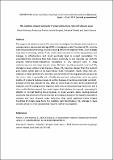Por favor, use este identificador para citar o enlazar a este item:
http://hdl.handle.net/10261/246851COMPARTIR / EXPORTAR:
 SHARE
BASE SHARE
BASE
|
|
| Visualizar otros formatos: MARC | Dublin Core | RDF | ORE | MODS | METS | DIDL | DATACITE | |

| Título: | CO2 injection‐induced seismicity in deep sedimentary rock and volcanic areas |
Autor: | Vilarrasa, Víctor CSIC ORCID ; Parisio, Francesco CSIC ORCID; Rutqvist, Jonny; Olivella, Sebastià; Carrera, Jesús CSIC ORCID | Palabras clave: | Induced Seismicity Volcanic areas |
Fecha de publicación: | 1-jul-2021 | Citación: | GEOMECH IRN online workshop: Couplings in Environmental Geomechanics, Barcelona, Spain, 1-2 July 2021 | Resumen: | The urgency of action to reduce CO2 emissions to mitigate the climate crisis requires to upscale carbon capture and storage (CCS) to the gigaton scale. The injected CO2 not only does induce pressure buildup, but also cooling around the injection wells. Such changes may induce seismicity, which, if felt, could cause nuisance to the local population and damage to infrastructure and could eventually lead to project cancellation. To understand the processes that may induce seismicity in CCS projects, we perform coupled thermo-hydro-mechanical simulations of CO2 injection both in deep sedimentary rock and deep volcanic areas. We have recently proposed to extend CO2 storage to deep volcanic areas because, there, CO2 becomes denser than the resident pore water, which stays in its supercritical state. Simulation results show that CO2 injection in deep sedimentary rock has a low potential of inducing seismicity because 1) the stress state is generally not critically stressed and sedimentary rocks are quite ductile, 2) pressure buildup is easy to control because it becomes practically constant, because of the low viscosity of CO2, after an initial sharp increase at the beginning of injection, and 3) cooling around injection wells induce thermal stresses reduction and a stress redistribution around the cooled region that tightens the caprock, improving its stability in normal faulting stress regimes. In deep volcanic areas, cooling-induced seismicity may dominate after a few years of injection because of the larger temperature contrast and thus, thermal stress reduction, that could reactivate faults located hundreds of meters away from the injection well. Nonetheless, CO2 storage in deep volcanic areas is a new concept that requires further investigation. | URI: | http://hdl.handle.net/10261/246851 |
| Aparece en las colecciones: | (IDAEA) Comunicaciones congresos |
Ficheros en este ítem:
| Fichero | Descripción | Tamaño | Formato | |
|---|---|---|---|---|
| Vilarrasa_et_al_2021_Abstract_IRN_GEOMECH.pdf | Proceeding | 838,55 kB | Adobe PDF |  Visualizar/Abrir |
CORE Recommender
Page view(s)
169
checked on 24-abr-2024
Download(s)
87
checked on 24-abr-2024
Google ScholarTM
Check
NOTA: Los ítems de Digital.CSIC están protegidos por copyright, con todos los derechos reservados, a menos que se indique lo contrario.
